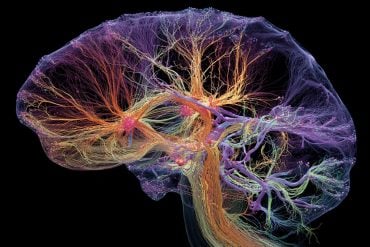Summary: Scientists have discovered that a molecule called kalata B1, found in violets, can significantly enhance the effectiveness of the chemotherapy drug Temozolomide (TMZ) in treating glioblastoma. This synthetic molecule reduced the amount of TMZ required to kill cancer cells by over tenfold in lab tests.
Researchers believe that the synthetic version of kalata B1, which mirrors the natural molecule’s structure, could be a potential breakthrough in glioblastoma treatment. While the discovery is promising, the team stresses that clinical trials are still far off.
Key Facts:
- Kalata B1, derived from violets, enhances chemotherapy’s effectiveness by tenfold.
- Synthetic kalata B1 matches the natural molecule in structure and efficacy.
- Testing on mouse models is the next step before potential clinical trials.
Source: Brain Chemistry Labs
Glioblastoma is one of the most serious brain diseases known. More than 45% of brain cancers are gliomas.
Only half of glioblastoma patients respond to the FDA-approved chemotherapy Temozolomide (TMZ). Even for those patients, the cancer cells quickly evolve resistance.
Most patients pass away within 12 to 16 months after diagnosis, and few make it beyond five years.
Now a glimmer of hope for patients comes from an unlikely place: Jackson Hole, Wyoming, where scientists at the non-profit Brain Chemistry Labs have been studying molecules found in violets.

Violets produce a dazzling suite of small circular peptides called cyclotides. They roughly appear in shape “like floppy frisbees,” says Dr. Samantha L. Gerlach. “They have been found active in the test tube against certain types of human cancer cells.”
Disulfide crosslinks which maintain the shape of cyclotides may help them create pores in the membranes of cancer cells. Within the plant, cyclotides provide protection against insect herbivores, fungal infections, and viruses.
Cyclotides were originally discovered from an herbal tea used by indigenous people in Africa to ease the course of childbirth. The tea was made from a plant they call kalata-kalata and which scientists call Oldenlandia affinis.
An international team led by scientists in Jackson Hole announced last week in the Swiss journal Biomedicines that the cyclotide kalata B1 turbocharges the activity of the chemotherapy TMZ, decreasing the amount necessary to kill glioblastoma cells by over ten-fold. Senior author Dr. Gerlach and her colleagues demonstrated that a synthetic version of kalata B1 has equal efficacy to the natural molecule.
“While kalata B1 commonly occurs in violet species, extraction from plant material yields only miniscule amounts,” Gerlach states.
“Working day and night for months, the minimal quantities we obtain are insufficient for clinical research.”
Through a collaboration with CSBio in California, the scientists were able to obtain much larger quantities of the synthetic version sufficient for testing in mouse models of glioblastoma.
The structure and efficacy of synthetic kalata B1 was found to be equivalent in all respects to the naturally occurring molecule. Dr. Krish Krishnan at California State University, Fresno used Nuclear Magnetic Resonance (NMR) spectroscopy to confirm the shape and folding of the synthetic molecule.
“Our cell data suggest that we can now move forward with the synthetic version in mice models,” Dr. Rachael Dunlop at the Brain Chemistry Labs stated. This next step of testing in mice will occur in Vienna, Austria.
While Brain Chemistry Labs Director Dr. Paul Alan Cox believes that the advent of synthetic kalata B1 could be a major step forward, he is cautious about overstating the significance for patients.
“We are still a long ways from clinical trials, but now the way is clear to determine if it might be safe for further testing.”
About this glioblastoma brain cancer research news
Author: Marilyn Asay
Source: Brain Chemistry Labs
Contact: Marilyn Asay – Brain Chemistry Labs
Image: The image is credited to Neuroscience News
Original Research: Open access.
“Kalata B1 Enhances Temozolomide Toxicity to Glioblastoma Cells” by Samantha L. Gerlach et al. Biomedicines
Abstract
Kalata B1 Enhances Temozolomide Toxicity to Glioblastoma Cells
Glioblastoma (GBM) is the most aggressive cancer originating in the brain, but unfortunately combination treatments with resection, radiation, and chemotherapy are relatively ineffective. Therefore, novel methods of adjuvant therapy are critically needed.
Cyclotides are plant-derived circular peptides that chemosensitize drug-resistant breast cancer to doxorubicin.
We analyzed naturally occurring and synthetic cyclotides (Cycloviolacin O3, Cycloviolacin O19, natural Kalata B1, synthetic Kalata B1, and Vitri E) alone and in co-exposure treatments with the drug temozolomide (TMZ) in human glioblastoma cells.
The cyclotides were identified by UPLC-PDA and HPLC-UV. The synthetic Kalata B1 sequence was verified with orbitrap LC-MS, and structural confirmation was provided by NMR spectroscopy.
The cyclotides displayed dose-dependent cytotoxicity (IC50 values 2.4–21.1 µM) both alone and as chemosensitizers of U-87 MG and T 98 cells to TMZ. In fact, a 16-fold lower concentration of TMZ (100 µM) was needed for significant cytotoxicity in U-87 MG cells co-exposed to synthetic Kalata B (0.5 µM).
Similarly, a 15-fold lower concentration of TMZ (75 µM) was required for a significant reduction in cell viability in T 98 cells co-exposed to synthetic Kalata B1 (0.25 µM). Kalata B1 remained stable in human serum stability assays. The data support the assertion that cyclotides may chemosensitize glioblastoma cells to TMZ.






